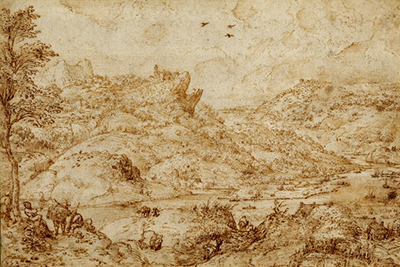Here Bruegel displays his impressive sketching ability with another landscape scene produced in pen and ink. Despite being highly skilled within this medium, the artist is far better known for his famous paintings, such as Hunters in the Snow and Fall of Icarus.
This drawing features a mounded area towards the back, which reaches upwards on the left hand side, and again on the right. Through the middle sweeps a narrow river which makes its way calmly through the landscape. We find a whole series of dips and raises, with trees dotted all around this setting. In the foreground is a tall tree to the left which is purposely added there in order to provide a vertical guide around which everything else can be compared. Several human figures below it create some activity as well as a sense of perspective that would otherwise be harder to grasp. The nearest elements are a little darker in order to further enhance the relative positioning of each part of the drawing.
Despite his own local area being famously flat, Bruegel was able to travel around Europe and find more exciting and undulating areas for his work. This method of working with pen and ink enabled him to keep his skills fresh and also work more quickly than when he was using oils. Additionally, such drawings could easily be reproduced as prints which could then be sold on for additional income that could help fund further trips as well as enabling him to remain fairly independent as an artist, and not be forced into working only on directed commissions, which was the case for most other artists at this time. Etching and woodcut techniques were used as the intermediary between the drawings and final prints.
There has been an increased focus on the old masters' drawings in recent years as this art form ungoes something of a revival. These items are impossible to put on display in the normal way, because of their fragility, but many collections have framed them and allow visitors to see them from time to time, under strict conditions. Many drawings have been uncovered from Bruegel's career and they continue to be well preserved today as their intrinsic value is now much better understood. The same goes for many others from the Flemish regions as well as further south in the Italian Renaissance.




